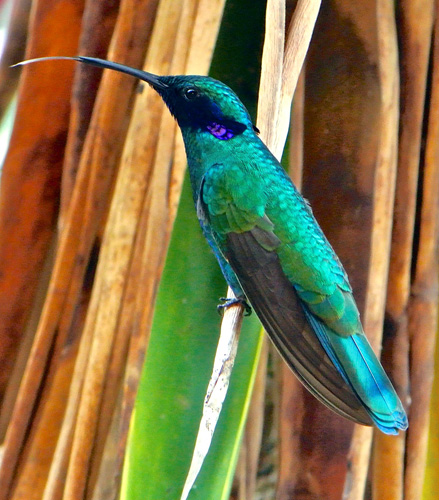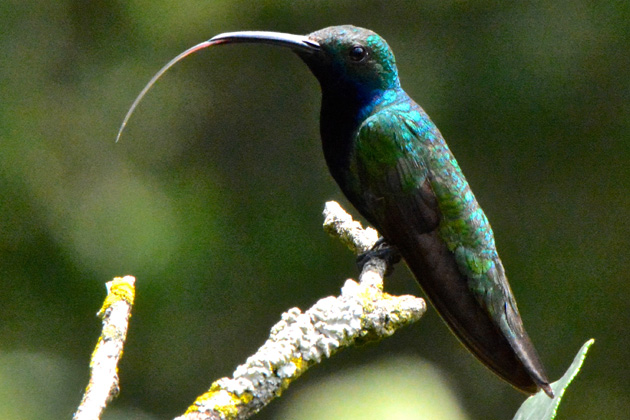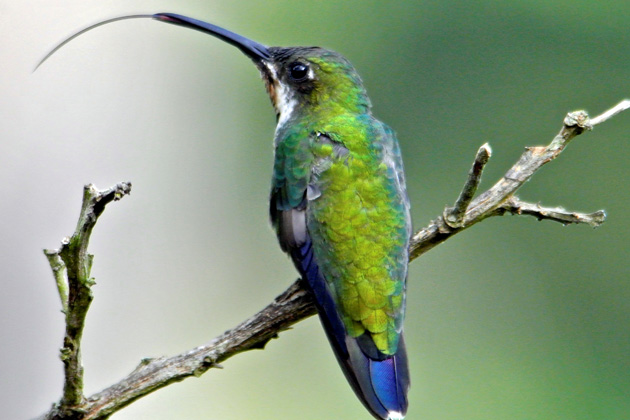When hummingbirds show up in the garden looking for dinner, there’s a lot more going on than meets the eye.
Brightly colored hummers can beat their wings up to 50 times per second as they hover over flowers, extracting nectar. And while common belief among biologists has long held that their feeding is facilitated by ‘wicking’ – capillary action that allows liquid to flow through small spaces without benefit of gravity – a UConn study published in the current issue of the Proceedings of the Royal Society B: Biological Sciences, debunks that theory.

The research, conducted by research scientist Alejandro Rico-Guevara and Professor Margaret Rubega from the Department of Ecology and Evolutionary Biology and Tai-Hsi Fan, associate professor of mechanical engineering, looked at 18 hummingbird species from seven of the nine main hummingbird groups throughout the Americas. They concluded that the ‘wicking theory’ is wrong, and that the bird’s tongue actually acts as a tiny pump.
Rico-Guevara explains that a hummingbird’s tongue, which can be stuck out about the same length as its beak, is tipped with two long skinny tubes, or grooves. Rather than wicking, he says, the nectar is drawn into the tongue by the elastic expansion of the grooves after they are squeezed flat by the beak.
The tongue structure is collapsed during the time it crosses the space between the bill tip and the nectar pool, but once the tip contacts the nectar surface, the supply of fluid allows the collapsed groove to gradually recover to a relaxed cylindrical shape as the nectar fills it.
When the hummingbird squeezes nectar off its tongue during protrusion, it is collapsing the grooves and loading elastic energy into the groove walls. That energy subsequently facilitates the pumping of more nectar.
Actually, everything is relative. When Rico-Guevara says the collapsed groove ‘gradually recovers’ as it fills with nectar, he is talking about an event that is infinitesimally brief, since the entire action takes place in less than a tenth of a second.
In fact, it is the speed that first made Rubega and Rico-Guevara skeptical about the role that wicking might play in the feeding process. They were convinced that the slow fill speed of capillary action would limit the hummingbird’s rate of absorbing nectar and thus its energy intake rate. This is where Fan’s expertise in fluid mechanics and biological transport came in handy.
“We could see the actual drinking mechanism through high speed video,” says Rico-Guevara, “but we couldn’t develop the fluid dynamics model needed to test our biophysical hypothesis.” In collaboration with Fan, an expert in fluid mechanics and biological transport phenomena, the biologists were able to test different hypotheses and validate the physics behind their explanation.

Rubega says most previous studies involving hummingbird feeding were conducted under artificial conditions in laboratories where the birds had access to feeders that had far more liquid available than would actually be found in flowers in the wild.
The research she and Rico-Guevara conducted involved filming free-living hummingbirds that had never been handled as they fed at modified transparent feeders that simulated the shape, nectar volumes, and concentrations of actual hummingbird-pollinated flowers. The data they collected from this wild population is the largest data set on hummingbird feeding mechanics to date.
Rubega says it’s important to understand evolution and the relationship between flowers and birds. She notes that flowers don’t give nectar away without expecting something in return.
“Nectar is kind of a bribe,” she says. “It’s payment for the hummingbird to come frequently enough so that they will go off and act as pollinators to other flowers of the same species. ”
Rico-Guevera adds that during their evolution, hummingbirds became what they are because of their skill at drinking nectar.
The researchers say their study found an excellent match between what mathematical models predicted and what they were observing through high-speed video.
“Our research shows how they really drink and provides the first mathematical tools to accurately model their energy intake,” says Rico-Guevara, “which will in turn inform our understanding of their foraging decisions and ecology.”



